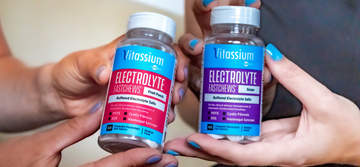
Vitassium welcomes guest posts from those in our community. Today, we are thrilled to feature a guest post authored by Natasha Graves, MPH, MBA, CHES, patient advocate and Founder and CEO of VacayAbility. Vitassium supports Natasha’s mission to build awareness and advocate for treatment options among underrepresented communities.
The events of this past year have only further amplified the need for change in addressing the racial, class, gender, and other systemic disparities that exist in our society. These undisputed disparities have such a horrendous and potentially life threatening impact on housing, education, the workforce, healthcare and quality of life.
One of the aspects that really hits home for me is the disparities in healthcare, especially how race and ethnicity impacts people with chronic illness.

My symptoms began right after my first homecoming at Howard University, but I was told that I was only sick because I was “probably dressed provocatively at homecoming events” by the emergency room nurse. In reality, I had been battling multiple chronic illnesses including postural orthostatic tachycardia syndrome (POTS), a common autonomic disorder that impacts an estimated 1-3 million Americans, mostly young women. My diagnostic journey had been complicated, as it took two years to receive a diagnosis after my symptoms began at eighteen years old and have been impacted by multiple underlying conditions.
I feel like I have been fortunate however, as the average POTS patient takes over four years to get diagnosed and sees seven doctors prior to being diagnosed with POTS. Due to a lack of awareness amongst medical professionals, about 75% of POTS patients are misdiagnosed with a psychological condition or told they are "crazy" prior to finding out they have POTS. Personally, I was told for years that I was crazy, anxious, and that I “just felt my heart more than normal people." In reality, I have a serious autonomic nervous system disorder that affects my ability to regulate my temperature, heart rate, blood pressure, breathing and digestive system. Over ten years later, I am still attempting to find the best treatment to manage my symptoms, and as of right now, there is no cure for POTS.
Throughout my journey, I have been on a mission to educate people about the different chronic illnesses that I have, through working with different organizations and documenting my own journey. This led me to connect with Vitassium, as the brand has been working to connect with real people who use their products. More recently, I have been evolving my personal mission to work on creating a more inclusive and accessible world.

However, since I started this journey, I have not found many people in support groups (until I helped launch one myself), research studies or media coverage about autonomic disorders that look like me, a woman of color. Personally, there is something both comforting and powerful in connecting with other Black women who know what I’m going through. There is strength, safety, pride, and community associated with being a woman of color. I have found it isolating not seeing the Black community or other people of color well-represented in the chronic illness world. I would love to tell you this is because people of color don’t suffer from chronic illness that often, but unfortunately, that’s not the case.

While chronic illness plagues all races and ethnicities in the United States, people of color face higher rates of diabetes, obesity, stroke, heart disease, and cancer than whites. The risk of being diagnosed with diabetes is 77% higher for African Americans and 66% higher among Hispanics, than for whites. Asian Americans, Native Hawaiians, and Pacific Islanders are at twice the risk of developing diabetes than the population overall.
In addition to higher rates of chronic illness, lower wages, geographical location, lack of representation in healthcare, and insufficient insurance coverage among people of color greatly limits access to treatment and often forces people of color to work while ill.
The American Heart Association has stated that, “Recent research shows that heart disease risk differs among African Americans, blacks from the Caribbean and African immigrants. American blacks have a higher level of cardiovascular risk. What we hear from this science is that race itself is not a risk factor. Rather, deep societal ills are hurting the hearts of black men and women in our nation.” In terms of the autonomic nervous system, research shows that heart rate variability among African Americans differs in geographical locations with higher levels of racism.
The explicit discrimination towards Black people and other people of color is hurting our society in more than just the overt ways that are typically thought about. Not only conscious prejudices and racism, but implicit bias is associated with negative physical and mental health consequences.
Research data shows that POTS, one of the most common autonomic disorders, is much more common in the white population (about 94%-96% of identified POTS patients are white), but it isn’t clear how much these percentages are influenced by major gaps in access to quality healthcare for people of color as well as the consequences of the lack of representation in healthcare. POTS is a condition that is difficult to receive a diagnosis for, regardless of race, due to lack of physician and public awareness. It is likely that due to discrimination, lack of representation and lack of diversity in healthcare, people of color are having an even more difficult time getting diagnosed.
Once a person of color is able to access healthcare, many research studies on a wide variety of medical problems show that racial discrimination in healthcare is a serious and far reaching problem, with doctors often dismissing symptoms, refusing to offer treatments, forgoing tests and missing diagnoses more often in people of color. This discrimination contributes to the inequalities that have left people of color with unbelievable health disparities, and worse overall health outcomes in the United States.

Source: Association of American Medical Colleges
What contributes to this? According to the Association of American Medical Colleges, only about 36% of active physicians are female. Only about 5% of physicians identify as Black or African-American, despite this group making up 13% of the U.S. population, and fewer than 6% of physicians identify as Hispanic, despite Hispanics making up about 19% of the U.S. population.
The lack of diversity and representation in healthcare that leads to not only implicit bias, but other factors including a lack of trustworthiness of providers (which leads to discomfort in disclosing potentially crucial health information) and a lack of education and cultural competency towards treating people of color. Some conditions present differently in people of color, especially as much education and clinical research focuses on presentation in white patients.

For example, it's not uncommon for people of color to be misdiagnosed or overlooked in dermatology. Cutaneous conditions were first portrayed on white skin in medical textbooks, establishing white skin as the "norm." Black and white medical schools were also segregated in the U.S. until the mid 20th century, such that white dermatologists -- who were and still are the majority -- were not trained to treat conditions on Black skin. Although the field has diversified some in recent decades, one 2018 study found that just 4.5% of images in medical textbooks showed conditions on dark skin.
This issue transcends all specialties in healthcare. Systematic disparities and barriers have only contributed to the lack of diversity and representation in healthcare. Although my personal advocacy journey began with a focus on POTS and dysautonomia, it has evolved to encompass all health disparities. Just as many people with dysautonomia have additional comorbidities, bias in healthcare can be seen throughout the diagnosis and treatment of all chronic illnesses. I want to make a point that it isn’t just dysautonomia care where we see issues with inclusive healthcare.
Awareness of these issues is the first, but not only step in addressing the inequalities in our society. To learn more about POTS and Dysautonomia, you can visit Dysautonomia International.







